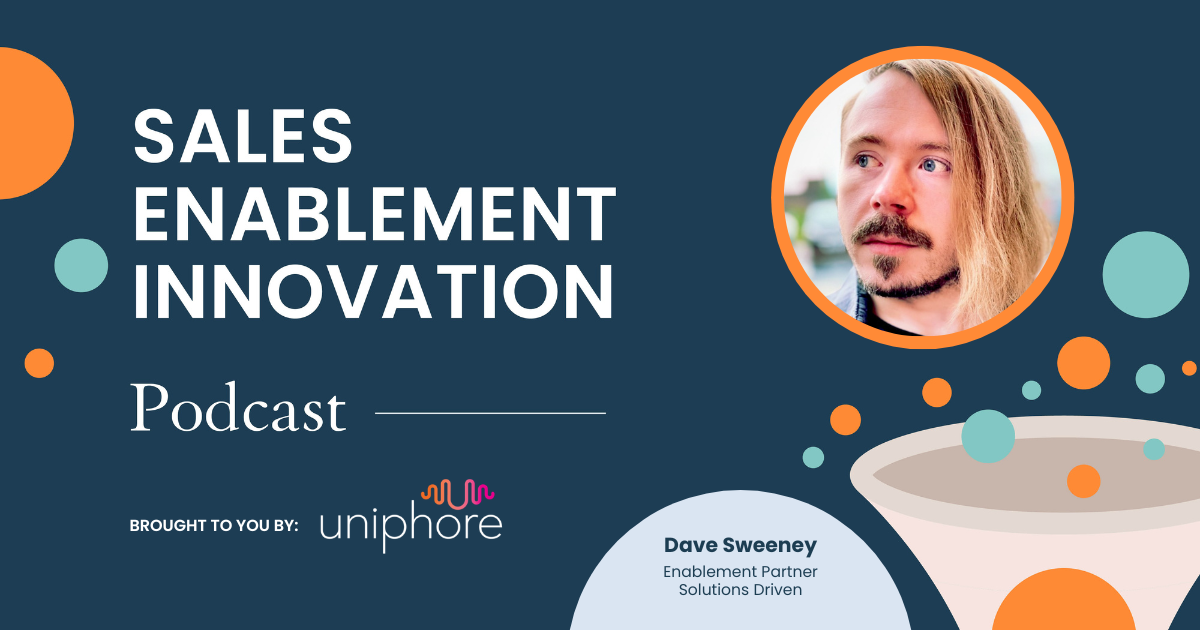This article is adapted from Brandon Flowers and Bobbi Jo Frazier’s talk, ‘Mastering solo enablement’, at the Austin 2023 Sales Enablement Summit. Check out the full presentation here.
In the fast-paced world of sales enablement, the role of a solo enablement professional is undoubtedly challenging to navigate - it requires resilience, adaptability, and a strategic mindset to seize the opportunities that come your way.
In this article, we’ll dive into how to make solo enablement work as we uncover the invaluable wisdom shared by two industry experts:
- Brandon Flowers, Director of Sales Enablement at Power Factors, and
- Bobbi Jo Frazier, Director of Revenue Enablement at ActivTrak.
So, if you're ready to enhance the power of solo enablement, learn from some of the best in the field, and elevate your impact within your organization, dive into:
- Setting the stage for solo enablement
- Building relationships and leveraging resources
- Scaling, managing information overload, and building visibility
- Strategic engagement, measuring results, and driving growth
- Final thoughts
👇
Setting the stage for solo enablement
The power of a team charter
When you find yourself as the sole person responsible for enablement, especially if you're new to the company, where do you begin? Brandon recognizes the need for clarity and direction in situations like this.
Drawing from his experience, he highlights the significance of building a team charter. By creating this charter, enablement professionals can clearly articulate their expectations, priorities, and measurements to their executive board, fostering a clearer understanding of how to work together effectively.
Bobbi adds that while team charters are essential, they should also be dynamic documents that adapt to the evolving needs and priorities of the organization.
In startups, where priorities shift frequently, she suggests viewing the charter as a flexible guidepost, serving as a foundation for enablement activities while allowing for adjustments as the company grows.
Understanding organizational priorities
In solo enablement, it’s vital to align your priorities with the organization's goals and objectives. Brandon shares his experience transitioning between companies where they had entirely different focal points and priorities.
By assessing the executive team's priorities, he reshaped his understanding of enablement, ensuring his efforts aligned with what the organization valued most.
Understanding the enablement maturity of your company helps prioritize and deliver impact where it matters most.
Bobbi agrees, emphasizing the need to be mindful of your organization's enablement maturity.
Instead of investing all your time in areas that may not align with current priorities, it is crucial to focus on initiatives that have the most significant impact on the company's growth and success.
Being strategic and adaptable allows solo enablement professionals to make the most of their limited resources.

Building relationships and leveraging resources
Collaborating for success
Brandon stresses the importance of teamwork, even for solo enablement professionals. By leveraging subject matter experts, collaboration teams, and frontline managers, solo enablement can transform into a team effort.
Engaging these experts not only enhances the quality of enablement programs but also fosters their own sense of ownership and investment in the process.
Bobbi suggests leaning on subject matter experts to lead enablement sessions. Involving marketing, product, and operations teams not only brings valuable content to the table but also empowers them to showcase their expertise.
By letting these experts take the spotlight, solo enablement professionals can leverage their skills and create a collaborative environment that drives success.
Speaking the language of stakeholders
Building relationships effectively, however, extends beyond just collaboration within the organization.
Solo enablement professionals need to understand the perspectives and goals of different teams, such as sales, marketing, and executives, to successfully communicate and align their efforts.
Brandon emphasizes the need to understand the language of different teams and tailor communication accordingly. Sales teams, for example, care about results, numbers, and actionable insights.
By speaking their language and presenting information in an engaging and interactive manner, solo enablement professionals can capture their attention in a way that resonates and demonstrates value.
Bobbi expands on this, highlighting the importance of aligning programs to stakeholders' goals.
Understanding what drives each team and communicating how enablement initiatives contribute to their success builds trust and support.
By strategically engaging with stakeholders and speaking their language, solo enablement professionals can foster strong relationships and gain the buy-in necessary to achieve their objectives, actively seeking feedback to ensure enablement efforts align with their expectations.

Scaling, managing information overload, and building visibility
Maximizing resources and technology
Bobbi emphasizes the importance of leveraging technology to scale as a team of one.
Implementing a Learning Management System (LMS) or Content Management System (CMS) can be crucial step in efficiently delivering and organizing enablement content.
These tools allow solo enablement professionals to provide consistent and accessible training resources, ensuring that teams can access the information they need to succeed.
Brandon highlights the power of tools such as Confluence for documentation and Mindtickle for LMS. By centralizing information and creating a single source of truth, solo enablement professionals can streamline processes and facilitate collaboration.
These tools also enable data-driven insights, empowering enablement professionals to measure the effectiveness of their programs and make data-backed decisions.
Prioritizing and adapting
Solo enablement professionals must learn to prioritize their efforts strategically. Bobbi advises aligning enablement initiatives with the organization's current needs.
Understanding the enablement maturity and focusing on areas that have the most impact is crucial to maximize results.
Rather than pursuing all ideas or projects, it's important to assess their alignment with organizational priorities and the potential for positive outcomes.
Brandon adds that being self-directed and proactive is key to managing priorities effectively.
By developing a clear understanding of executive expectations, enablement professionals can set the right course of action and avoid micromanagement.
Building trust with managers and stakeholders allows for autonomy and decision-making authority, resulting in a more productive and impactful enablement role.
Navigating information overload
Information overload is a common challenge in today's digital workplace. Brandon acknowledges the diverse preferences within organizations, with some individuals favoring email while others thrive in platforms like Slack.
As a solo enablement professional, adapting to these preferences is crucial. Brandon suggests being a chameleon, tailoring communication methods to meet the needs of different stakeholders.
Bobbi shares her productivity strategies, including calendar blocking and color-coding, to manage information overload.
These techniques help create focused work time and enable the efficient organization of tasks and priorities.
By effectively managing communication channels and adopting productivity practices, solo enablement professionals can navigate information overload and maintain focus on critical tasks.
Building visibility and impact
Visibility and impact are essential for solo enablement professionals to demonstrate their value. Brandon stresses the importance of marketing yourself as a "business within a business."
By actively promoting successes and wins, solo enablement professionals can create a reputation for delivering tangible results.
Bobbi adds that building trust is fundamental to achieving visibility and impact. By establishing strong connections with teams, leaders, and stakeholders, solo enablement professionals gain credibility and support.
Openness, authenticity, and the willingness to have tough conversations foster trust and strengthen relationships within the organization.

Strategic engagement, measuring results, and driving growth
Measuring enablement results
Measuring enablement results is crucial for demonstrating impact and driving continuous improvement. Brandon highlights the importance of setting realistic expectations for measurement, especially in the early stages of enablement initiatives.
It is essential to communicate to executive teams that enablement is an ongoing journey, and immediate revenue correlation may not be immediate.
Solo enablement professionals must focus on building a foundation and gradually demonstrating the value of enablement efforts over time.
Building trust and relationships
Building trust and relationships is a foundational element of solo enablement. Bobbi emphasizes the need for authenticity and genuineness when engaging with teams and stakeholders.
By owning up to mistakes and showing a willingness to learn and adapt, solo enablement professionals can build trust and foster stronger relationships.
Brandon shares the importance of being proactive and self-directed to gain trust from managers and stakeholders.
By taking the initiative to create a team charter, seeking feedback, and leading discussions, enablement professionals can demonstrate their commitment to adding value and delivering results.
Proactively seeking input from stakeholders and involving them in the decision-making process further strengthens relationships and establishes enablement professionals as trusted partners.
Driving growth and success
Driving growth and success is the ultimate goal of solo enablement professionals. Brandon highlights the need for enablement professionals to market themselves, showcasing wins, promoting successes, and highlighting the value generated through enablement initiatives.
Bobbi emphasizes the importance of understanding the goals and objectives of the organization as a whole.
Solo enablement professionals must align their efforts with the broader business strategy to contribute meaningfully to growth.
By continuously assessing the organization's needs and adapting enablement initiatives accordingly, solo enablement professionals can drive growth and help the company reach its full potential.

Final thoughts
In conclusion, solo enablement is a dynamic and challenging role that requires resilience, adaptability, and strategic thinking.
By following the insights and best practices shared by Brandon and Bobbi, solo enablement professionals can navigate the complexities of their roles and drive success within their organizations.
In the tricky-to-navigate world of solo enablement, these insights and best practices provide a roadmap for success.
By applying and tailoring the wisdom shared by our experts, solo enablement professionals can unleash their full potential and make a significant impact within their organizations.
So, whether you're just starting your journey as a solo enablement professional or looking to enhance your existing role, remember the power of team charters, strategic engagement, leveraging resources, managing information overload, and driving growth.
With dedication, perseverance, and a commitment to continuous improvement, you can truly unleash the power of solo enablement and thrive in your role!


Sales enablement insider
Thank you for subscribing
Level up your sales enablement career & network with sales enablement experts
An email has been successfully sent to confirm your subscription.
 Follow us on LinkedIn
Follow us on LinkedIn





